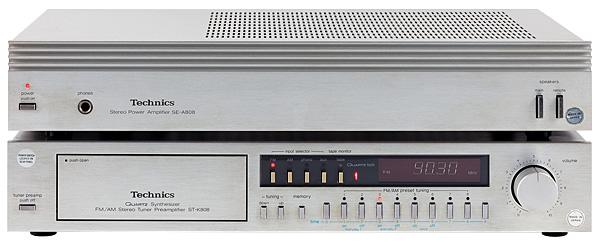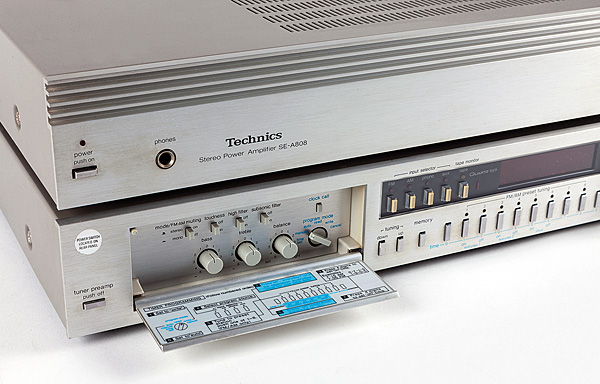Technics ST-K808/SE-A808 'preceiver'/power amplifier

 Launched in 1980, these slimline separates proved just the tonic for those seeking sophisticated sonics wrapped in eye-catching casework. How do they sound today?
Launched in 1980, these slimline separates proved just the tonic for those seeking sophisticated sonics wrapped in eye-catching casework. How do they sound today?
Who buys top quality hi-fi equipment? First there is the audiophile, who is willing to devote considerable resources in the pursuit of components that deliver what he or she regards as the best sound quality for a given budget. There was once also a largely non-technical group who had equally high musical expectations. Wealthy and design conscious, they wanted complete systems that not only sounded good but looked good too, and included all the latest technological refinements.
All Systems Go
In the UK it was Dynatron that best served this market to begin with, followed by Bang & Olufsen whose vast range went from the fairly basic to the state-of the art. It took the Japanese a while to cotton on to this niche, but by the end of the 1970s they too had plenty to offer in this arena.

Technics was ideally placed to compete for a slice of the pie. Established and respectable, the company was able to produce a matched set of components that all achieved the required standards without difficulty. The ST-K808 'preceiver' and SE-A808 power amplifier seen here were the centrepiece of just such a package, sold in the UK as the System 80s.
Aside from the outrageously expensive SP-10 based 'Ultimate System', System 80s was the priciest suggested combination in the Technics range. Introduced in 1980, it comprised the ST-K808 and SE-A808 along with the SL-Q33 turntable and RS-M45 cassette deck, both of which were fitted with direct-drive motors. To add a touch of high-tech garnish, the SH-R808 remote control unit enabled operation of all the units from a distance via a handset.
Three In One
All these units were typical of the 'slimline' look that emerged after the micro system craze, which had failed to convince customers that such tiny units were worth the large sums often asked for them.
Slimline cases addressed the problem by retaining the standard 430mm width of hi-fi components while reducing their height as much as possible. The resulting products still looked like 'proper' hi-fi, but were better suited to the new high density electronic assemblies that had left traditionally sized units full of empty space.
One would not expect Technics to scrimp on the phono stage and the ST-K808 did not disappoint, boasting a dedicated integrated circuit for each channel operated from a substantial 33V supply. The components that defined the RIAA characteristic came as a precision-made assembly, sealed to ensure long-term stability. Scratch and subsonic filters were included, along with loudness compensation and treble/bass controls.
To avoid cluttering the panel, these minor items were hidden behind a metal flap on the front of the unit. This also concealed the stereo/mono selector for the tuner and the various controls for the timer. The timer was a potentially useful feature as it enabled the system to start to play any radio programme at any time. It also enabled timed recordings to be made by the RS-M45, which included a 'timer start' function for this purpose.
Aside from some additional software, adding the timer did not require a great deal of extra circuitry or components. The only obvious sign of its presence was a heavy-duty relay that controlled the mains power outlets to the other units. Cheap timers used the frequency of the AC mains supply as a reference but the ST-K808 employed a quartz crystal instead. This allowed the clock to keep time even if the power was interrupted, backup reserves coming from three AA-sized cells fitted in a recess underneath.
The same battery also retained the memory for the tuner's eight-programme preset bank. The tuner itself looked outwardly simple but internally was microcomputer controlled and constructed around purpose-designed Technics integrated circuits. Unusually elaborate measures were taken to suppress the 19kHz pilot tone found in FM stereo broadcasts. Although largely inaudible, this could spoil off-air tape recordings if it wasn't filtered out correctly.
The SE-A808 power amplifier was a much simpler affair and had just three controls on its finned alloy fascia. These were the power switch and loudspeaker selectors, although the former was redundant if the SE-A808 was used with the switched power outlets of the ST-K808.
Sealed For Life
Hybrid chip based amplifiers tend to be simple budget models with both channels contained within a single module but the Technics implementation showed some sophistication by having one chip per channel and including a separate differential amplifier stage beforehand.

Inside, the layout was dominated by twin mains transformers and a large heatsink for the output devices – in this case two Sanyo STK1050 'power modules'. These thick film hybrid ICs contain most of the components of an amplifier's output stage, all assembled on a ceramic substrate and sealed into a metal-backed plastic module. Some of the components are deposited directly onto the ceramic itself, forming a highly stable assembly. Although normally of DC-coupled Class AB design, the majority of these hybrid ICs do not have the facility for bias or offset adjustment. Instead this is done during assembly and then sealed for life, which is advantageous for the equipment manufacturer.


























































